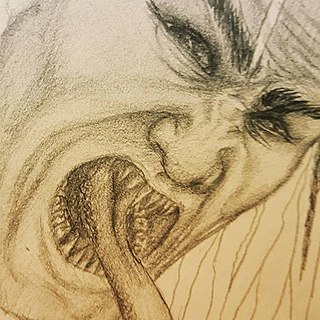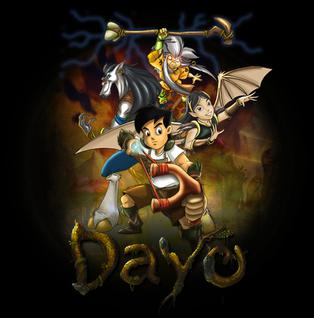Related Research Articles

The simurgh is a benevolent, mythical bird in Persian mythology and literature. It is sometimes equated with other mythological birds such as the phoenix and the humā, though it must be understood as a completely different mythological creature of its own. The figure can be found in all periods of Iranian art and literature and is also evident in the iconography of Georgia, medieval Armenia, the Eastern Roman Empire, and other regions that were within the realm of Persian cultural influence.

The manananggal is a mythical creature in the Philippines that is able to separate its upper torso from the lower part of its body. Their fangs and wings give them a vampire-like appearance.

Aswang is an umbrella term for various shape-shifting evil creatures in Filipino folklore, such as vampires, ghouls, witches, viscera suckers, and transforming human-beast hybrids. The aswang is the subject of a wide variety of myths, stories, arts, and films, as it is well known throughout the Philippines. Spanish colonists noted that the aswang was the most feared among the mythical creatures of the Philippines, even in the 16th century. Although with no specific motive other than harming others, their behavior can be interpreted as an inversion of the traditional Filipino's values. The aswang is especially popular in southern parts of Luzon, and some parts of Mindanao and Visayas, especially the Visayan province of Capiz.

In Philippine mythology, the kapre is a creature that may be described as a tree giant, being a tall, dark-coloured, hairy, and muscular creature. Kapres are also said to have a very strong body odour and to sit in tree branches to smoke.

The Tikbalang (/ˈtikbaˌlaŋ/) is a creature of Philippine folklore said to lurk in the mountains and rainforests of the Philippines. It is a tall, bony humanoid creature with the head and hooves of a horse and disproportionately long limbs, to the point that its knees reach above its head when it squats down. In some versions, it is a transformation of an aborted fetus sent to earth from limbo.

Philippine mythology is rooted in the many indigenous Philippine folk religions. Philippine mythology exhibits influence from Indonesian, Hindu, Muslim, Shinto, Buddhist, and Christian traditions.

The Sigbin or Sigben is a creature in Philippine mythology said to come out at night to suck the blood of victims from their shadows. It is said to walk backwards with its head lowered between its hind legs, and to have the ability to become invisible to other creatures, especially humans. It resembles a hornless goat, but has very large ears which it can clap like a pair of hands and a long, flexible tail that can be used as a whip. The Sigbin is said to emit a nauseating odor.

A kinnara is a creature from Hindu and Buddhist mythology. They are described as part human and part bird, and have a strong association with music and love. Believed to come from the Himalayas, they often watch over the well-being of humans in times of trouble or danger. An ancient Indian string instrument is known as the Kinnari vina. Their character is also clarified in the Adi Parva of the Mahabharata, where they say:
We are everlasting lover and beloved. We never separate. We are eternally husband and wife; never do we become mother and father. No offspring is seen in our lap. We are lover and beloved ever-embracing. In between us we do not permit any third creature demanding affection. Our life is a life of perpetual pleasures.

There are many Malay ghost myths, remnants of old animist beliefs that have been shaped by Hindu-Buddhist cosmology and later Muslim influences, in the modern states of Brunei, Indonesia, Malaysia, Singapore and among the Malay diaspora in neighbouring Southeast Asian countries. The general word for ghost is hantu, of which there exist a wide variety. Some ghost concepts such as the female vampires pontianak and penanggal are shared throughout the region. While traditional belief does not consider all ghosts as necessarily evil, Malaysian popular culture tends to categorise them all as types of evil djinn.
Pedro Penduko is a Filipino comic book character styled as a folk hero or superhero, created by National Artist for Literature Francisco V. Coching and debuted on the magazine Liwayway.
The Kumakatok are a group of three robed figures believed by many in the Philippines to knock on doors in the middle of the night and bring bad omens. They allegedly look like humans, but wear hoods that obscure their faces to some extent. One resembles a young female, a middle aged man and an elderly man. The omen will affect those that the group visited regardless whether they opened the door to invite the group or not.
The Batibat is a vengeful demon found in Ilocano folklore. In Tagalog folklore, the creature is called Bangungot. The batibat takes the form of an ancient, grotesquely obese, tree-dwelling female spirit. They usually come in contact with humans when the trees in which they reside are felled and are made homeless, especially when their tree is made into a support post for a house. This causes them to migrate and inhabit what is left of their tree. The batibat forbids humans from sleeping near its post. When a person does sleep near it, the batibat transforms into its true form and attacks the person by suffocating their victim and invading their dream space, causing sleep paralysis and waking nightmares. This condition lends itself to the Ilocano word for nightmare, "batíbat". To ward off the batibat, one should bite one's thumb or wiggle one's toes. In this way, the person will awaken from the nightmare induced by the batibat.
The tiyanak is a vampiric creature in Philippine mythology that takes on the form of a toddler or baby. Although there are various types, it typically takes the form of a newborn baby and cries in the jungle to attract unwary travelers. Once it is picked up by an unfortunate passerby, it reverts to its true form and attacks the victim. The tiyanak is also depicted to take malevolent delight in leading travelers astray, or in abducting children.
Mythic humanoids are legendary, folkloric, or mythological creatures that are part human, or that resemble humans through appearance or character. Each culture has different mythical creatures that come from many different origins, and many of these creatures are humanoids. They are often able to talk and in many stories they guide the hero on their journey.
Engkanto are mythical environmental spirits that are said to have the ability to appear in human form. They are often associated with the spirits of ancestors in the Philippines. They are also characterized as spirit sorts like sirens, dark beings, elves, and more. Belief in their existence has likely existed for centuries, and continues to this day.

Dayo: Sa Mundo ng Elementalia also called Niko: The Journey to Magika in English-speaking countries, is a 2008 animated adventure-fantasy comedy film and the Philippines' first all-digital full-length animated feature film. Produced by Cutting Edge Productions, the film revolves around Bubuy who has to save his grandparents who were abducted and brought to the strange land called Elementalia, home to a host of strange creatures from Philippine mythology. This $1.3 million production composed of over 500 local animators features a “tra-digital animation” technique using paperless 2D and 3D technologies. It has 2D animation for its characters and 3D animation for the backdrops.
Bungisngis is a one-eyed giant in Philippine folklore. This giant, purported to dwell in Meluz, Orion, Bataan and Batangas and is described as always laughing. The literal meaning of the name Bungingis is derived from the Tagalog word ngisi which means "to giggle".
In the Philippines, a handful of superstitious beliefs exist that are very famous amongst the natives. These beliefs are typically introduced to them at a very early age through children's books or bedtime stories. It is believed that if natives aren't careful to follow them, a curse will befall them.
References
- 1 2 Paraiso, Salvador; Jose Juan Paraiso (2003). The Balete Book: A collection of demons, monsters and dwarfs from the Philippine lower mythology. Philippines: Giraffe Books. ISBN 971-8832-79-3.
- 1 2 3 Ramos, Maximo D. (1971). Creatures of Philippine Lower Mythology. Philippines: University of the Philippines Press.